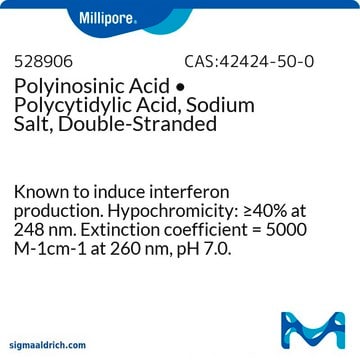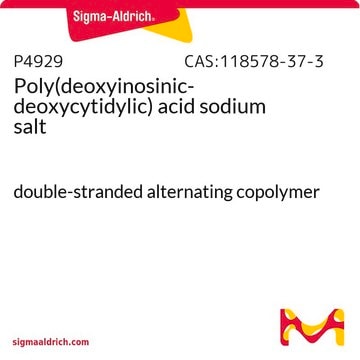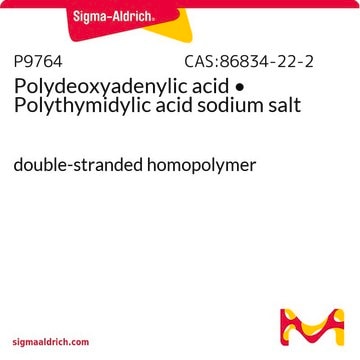P1530
Polyinosinic–polycytidylic acid sodium salt
TLR ligand tested
Synonym(s):
Poly (I:C), Poly(I) • Poly(C)
Sign Into View Organizational & Contract Pricing
All Photos(4)
About This Item
Recommended Products
Quality Level
Assay
≥99% (less than 1% free nucleotides, TLC)
form
lyophilized powder
storage condition
desiccated
solubility
H2O: 10 mg/mL
storage temp.
−20°C
Looking for similar products? Visit Product Comparison Guide
Application
TLR3 recognizes double-stranded RNA and is a major effector of the immune response against viral pathogens. Polyinosinic–polycytidylic acid (Poly(I) • Poly(C)) is a double-stranded homopolymer used as a model RNA to study cell signaling at the level of TLR3. Poly(IC) is a TRIF-dependent toll-like receptor-3 (TLR3) ligand.
Biochem/physiol Actions
Transfection of Poly (I:C) into NIT-1 cells has been used as a model of intracellular dsRNA-induced β cell apoptosis. Eighteen hours post transfection, 45% of the cells were apoptotic with an increase in NF-kB, p50/p65 nuclear translocation, and cleavage of caspases 3 and 8, as well as transcriptional induction of caspase 12, Fas, IL-15, and the TNF receptor-associated ligand (TRAIL). It has been suggested that Poly(I:C) is one of the most appropriate generators of stable mature dendritic cells (DC). These mature DC might generate in vivo effective immune responses after injection due to their ability to secrete bioactive IL-12 after CD40 ligation. Poly (I:C) was used as a potent adjuvant to enhance the specific anti-tumor immune responses against a peptide-based vaccine.
Other Notes
Double-stranded homopolymer.
Preparation Note
The product requires ionic strength to maintain the double-strand structure. To prevent denaturation, reconstitute in solutions with physiological salt concentrations (e.g., saline solution). Reconstitution may require heating (50 °C) and cooling to achieve re-annealing.
Storage Class Code
11 - Combustible Solids
WGK
WGK 3
Flash Point(F)
Not applicable
Flash Point(C)
Not applicable
Personal Protective Equipment
dust mask type N95 (US), Eyeshields, Gloves
Certificates of Analysis (COA)
Search for Certificates of Analysis (COA) by entering the products Lot/Batch Number. Lot and Batch Numbers can be found on a product’s label following the words ‘Lot’ or ‘Batch’.
Already Own This Product?
Find documentation for the products that you have recently purchased in the Document Library.
Customers Also Viewed
Yipeng Ren et al.
Fish & shellfish immunology, 70, 720-730 (2017-09-30)
Toll-like receptors, the best known pattern recognition receptors, play important roles in recognizing non-self molecules and binding pathogen-associated molecular patterns in the innate immune system. In the present research, the cDNA and protein characterization of the TLR signalling pathway genes
Ana Miar et al.
Cancer research, 80(23), 5245-5256 (2020-10-30)
Hypoxia is a common phenomenon in solid tumors and is strongly linked to hallmarks of cancer. Recent evidence has shown that hypoxia promotes local immune suppression. Type I IFN supports cytotoxic T lymphocytes by stimulating the maturation of dendritic cells
Fei Yuan et al.
Antiviral research, 147, 1-10 (2017-05-04)
The present study is focused on investigating the immunoprotective effects of CpG-ODN/Poly(I:C) combined with the viral glycoprotein gp90 protein against reticuloendotheliosis virus (REV) infection in chickens. REV's gp90 gene was amplified from the REV-infected cells and expressed in Escherichia coli
Baohong Wu et al.
Signal transduction and targeted therapy, 4, 11-11 (2019-05-03)
UTX (also known as KDM6A), a histone 3 lysine 27 demethylase, is among the most frequently mutated epigenetic regulators in myelodysplastic syndrome (MDS) and acute myeloid leukemia (AML). Recent studies have suggested that UTX mutations promote MDS and AML by
Svenja Fritzlar et al.
mBio, 10(3) (2019-06-20)
The integrated stress response (ISR) is a cellular response system activated upon different types of stresses, including viral infection, to restore cellular homeostasis. However, many viruses manipulate this response for their own advantage. In this study, we investigated the association
Our team of scientists has experience in all areas of research including Life Science, Material Science, Chemical Synthesis, Chromatography, Analytical and many others.
Contact Technical Service










